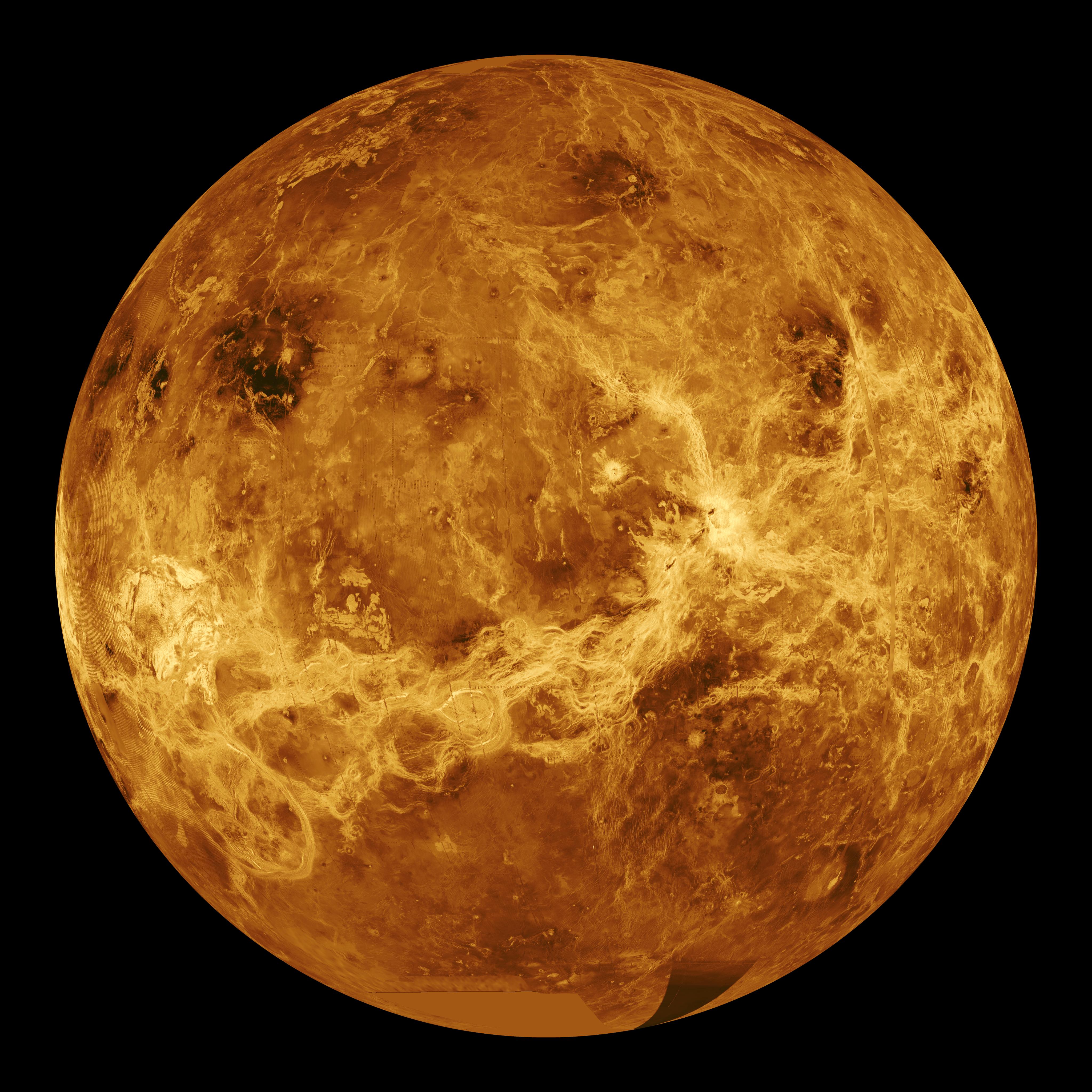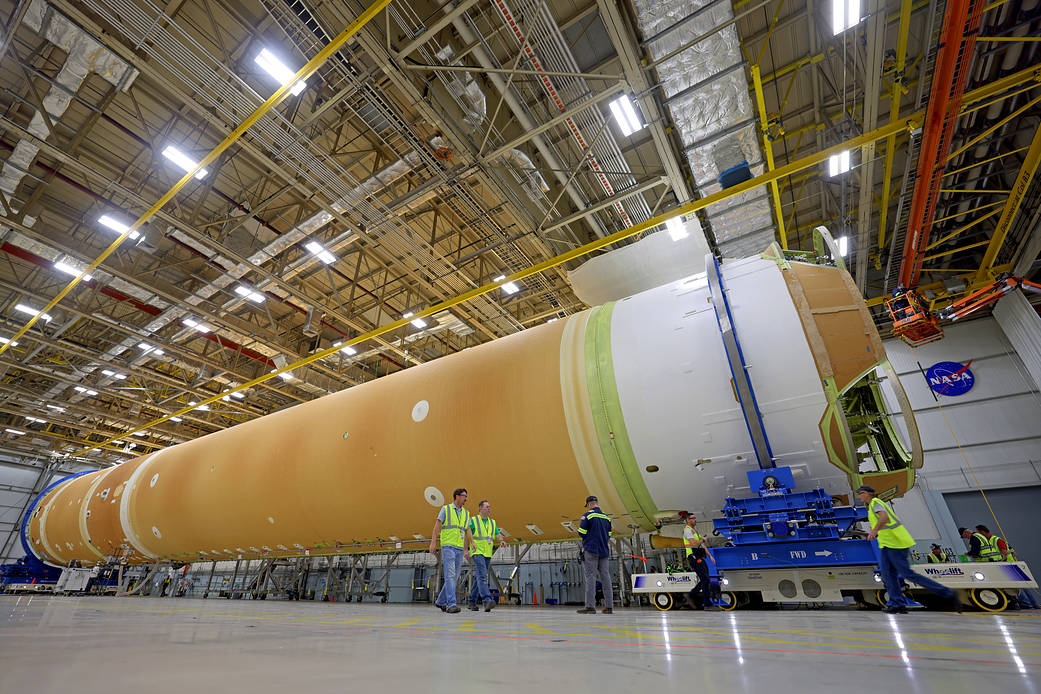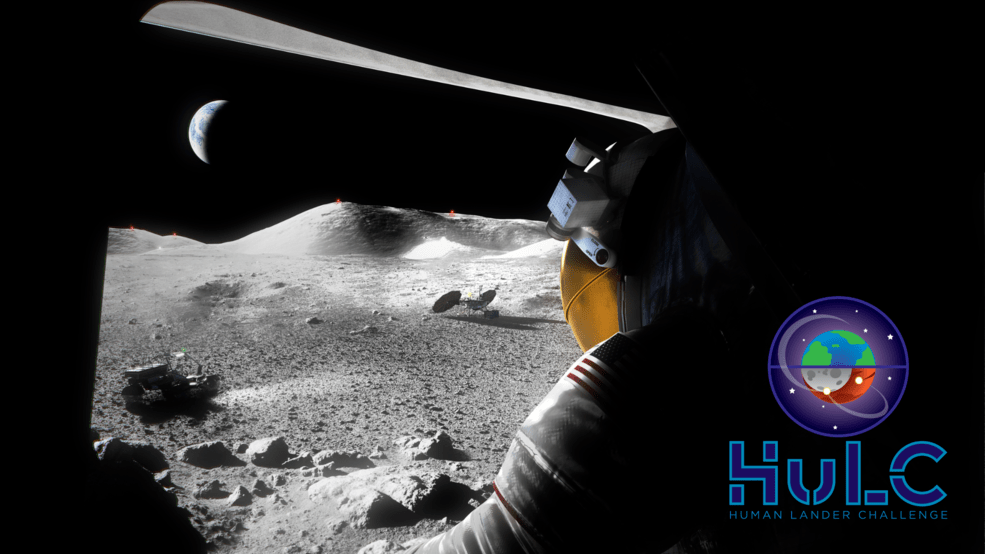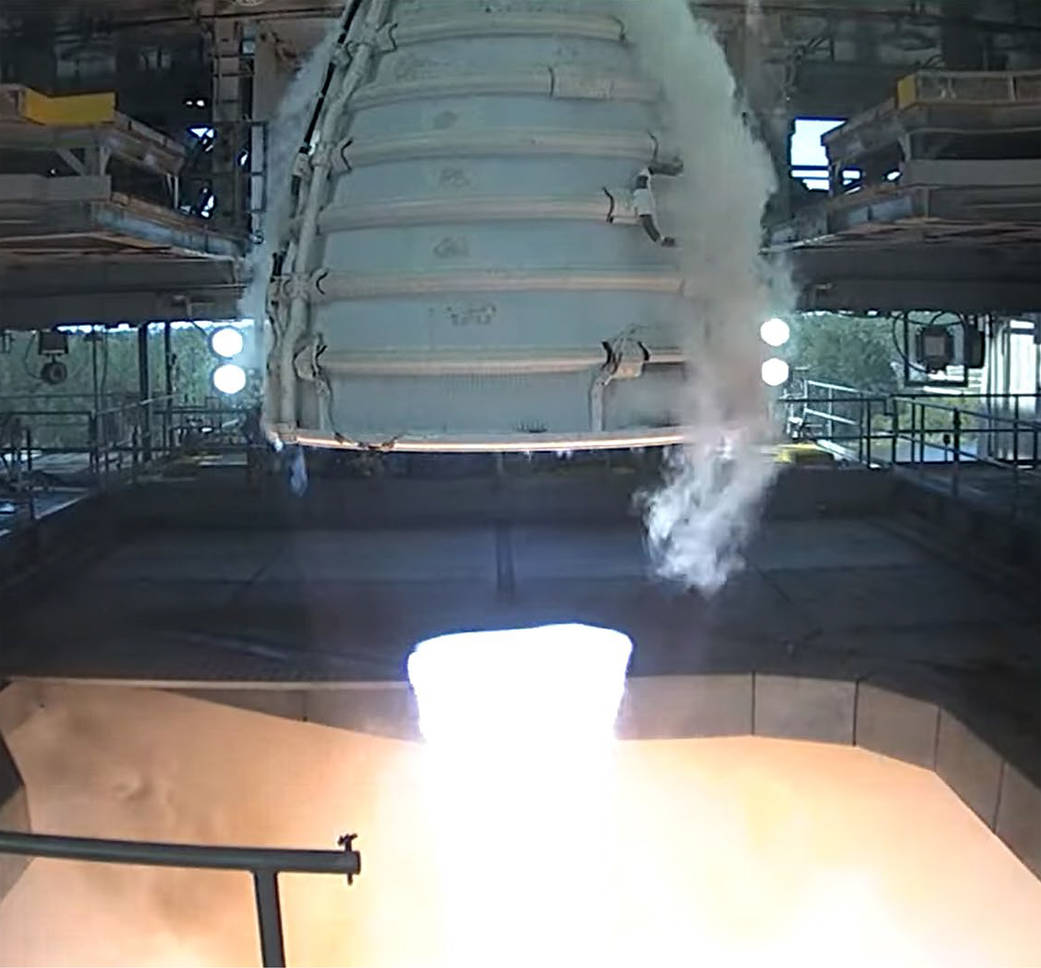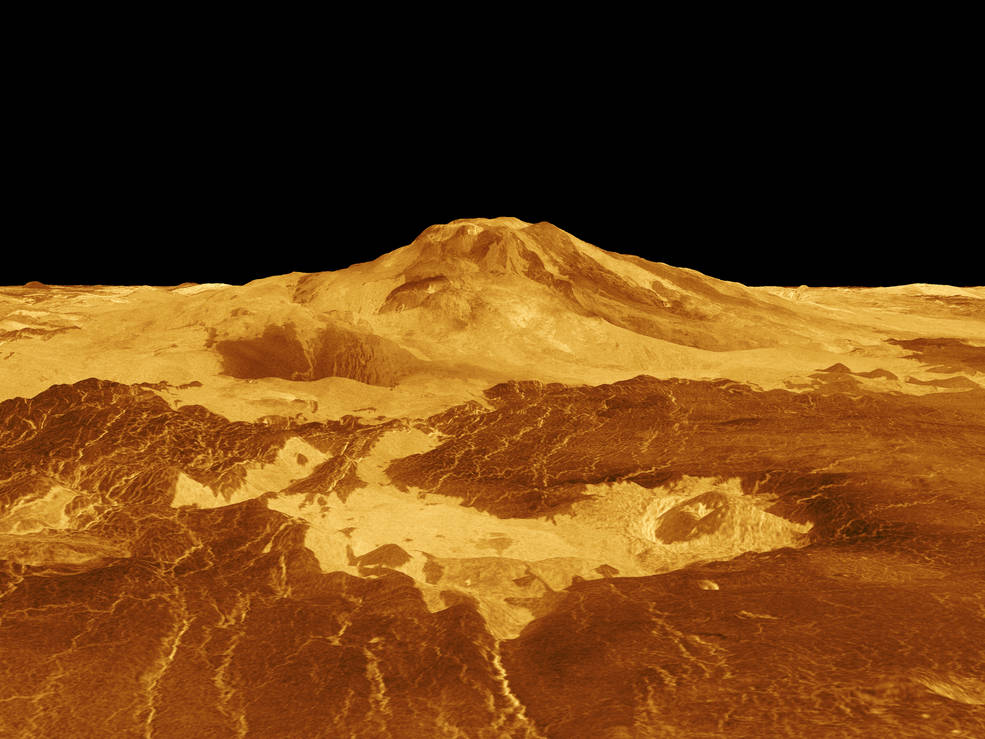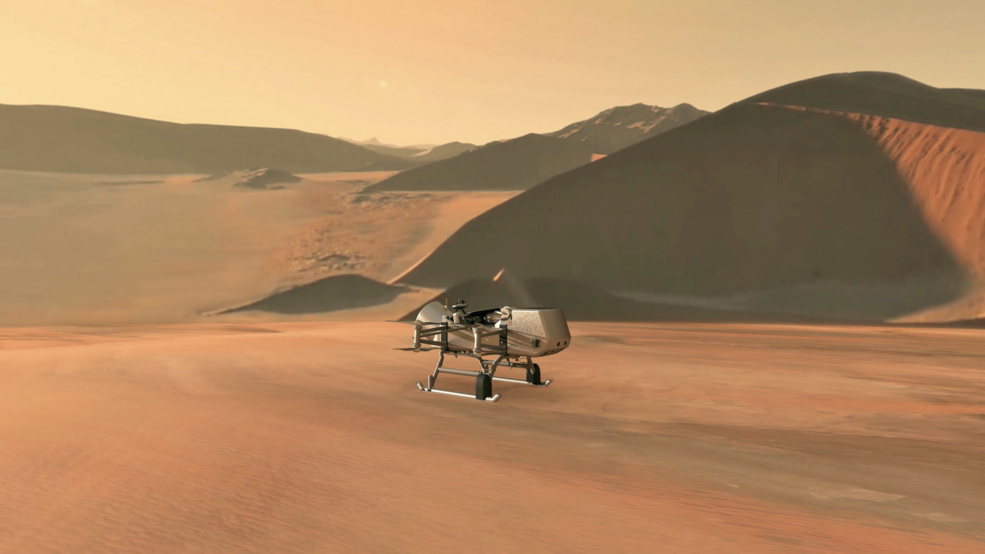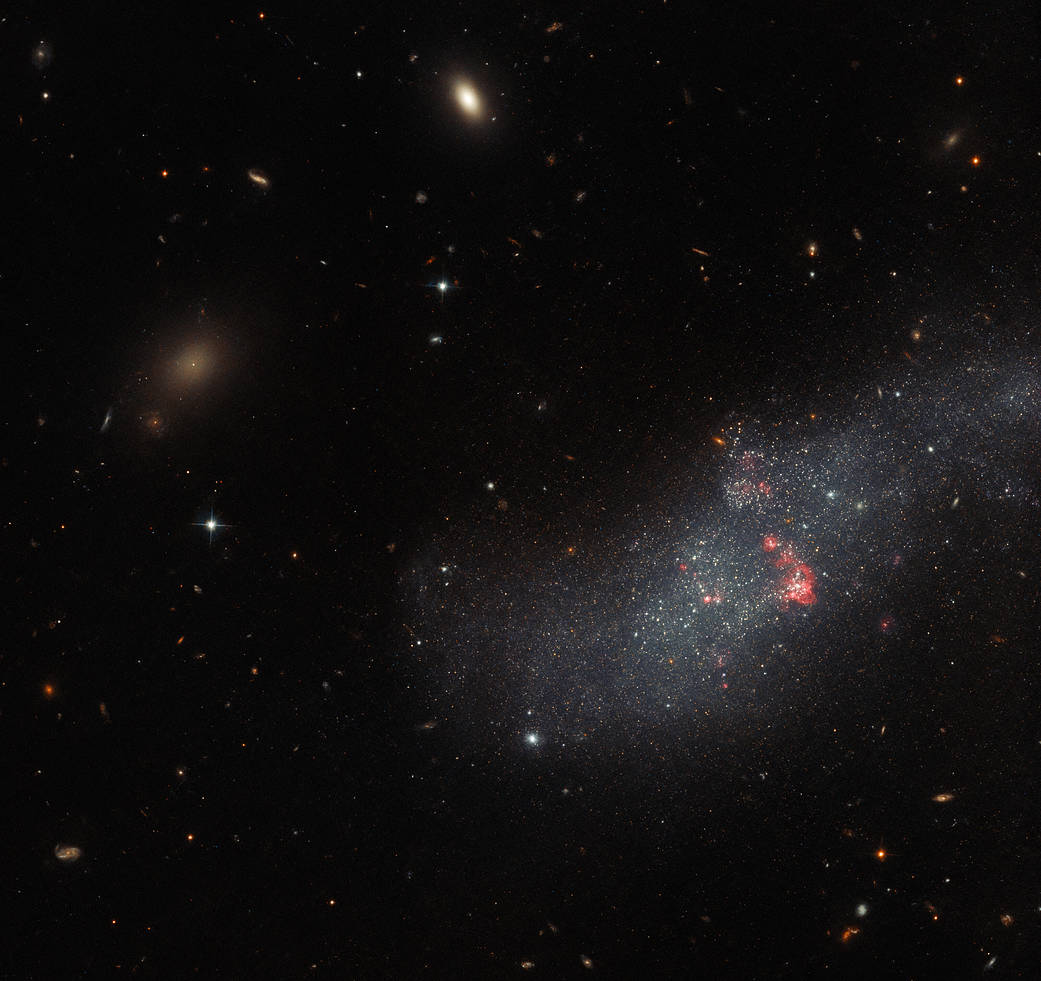The Marshall Star for March 22, 2023.
In This Week’s Star
- NASA Connects All Major Structures of Artemis II Moon Rocket Core Stage
- Marshall to Host 35th Small Business Alliance Meeting March 23
- NASA Seeks Student Solutions for Managing Moon Landing Dust Cloud
- Teams at Michoud Unbox RS-25 Engines for the First Crewed Artemis Mission
- NASA Conducts Long Duration Hot Fire of RS-25 Certification Engine
- Magellan Data Reveals Volcanic Activity on Venus
- Instrument Bound for Titan Could Reveal Chemistry Leading to Life
- Hubble Sees a Diminutive Dwarf Galaxy
NASA Connects All Major Structures of Artemis II Moon Rocket Core Stage
Teams at NASA’s Michoud Assembly Facility in New Orleans have fully integrated all five major structures of the Space Launch System (SLS) rocket’s core stage for Artemis II, the first crewed Artemis mission that will send four astronauts around the Moon and return them home. Technicians joined the engine section to the rest of the rocket stage March 17. Next, teams will integrate the four RS-25 engines to the engine section to complete the stage. Located at the bottom of the 212-foot-tall core stage, the engine section is the most complex and intricate part of the rocket stage, helping to power Artemis missions to the Moon. In addition to its miles of cabling and hundreds of sensors, the engine section is a crucial attachment point for the RS-25 engines and two solid rocket boosters that produce a combined 8.8 million pounds of thrust at liftoff. It houses the engines and includes vital systems for mounting, controlling, and delivering fuel from the propellant tanks to the engines. The core stage for Artemis II is built, outfitted, and assembled at Michoud. Through Artemis missions, NASA will land the first woman and the first person of color on the surface of the Moon, paving the way for a long-term lunar presence and serving as a steppingstone for astronauts on the way to Mars. (NASA/Michael DeMocker)
Marshall to Host 35th Small Business Alliance Meeting March 23
NASA’s Marshall Space Flight Center will host the 35th Marshall Small Business Alliance Meeting on March 23. The free, hybrid event will take place at the Davidson Center for Space Exploration and will also be streamed online via Microsoft Teams from 7:30 a.m. – 12:30 p.m. CST.
The event will feature updates from Marshall Center Director Jody Singer, NASA’s Office of Small Business Program, NASA’s Office of Procurement, and small business offices from multiple NASA Centers. The program will also include city leaders.
In addition to hearing from Singer, speakers include:
- David Brock, Marshall Small Business specialist
- John Cannaday, director, Marshall Office of Procurement
- Glen Delgado, associate administrator, NASA Office of Small Business Programs
- Jami Rodgers, director, Procurement Strategic Operations Division, NASA Office of Procurement
- Debbie Batson, Marshall prime contractor supplier council events coordinator, Teledyne Brown Engineering
- Ashely Farrier, director, Office of Small Business Programs, United States Special Operations Command, United States Special Operations Command
- Lucia Cape, senior vice president, Chamber of Commerce of Huntsville/Madison County
The mayors of Huntsville, Decatur and Madison will also provide remarks. For more information about speakers and topics, visit here.
The Marshall Small Business Alliance was created to provide industry with maximum exposure to the Marshall marketplace. This meeting is being held in conjunction with the NASA Office of Procurement, which oversees the acquisition process to support the successful accomplishments of the agency’s current and future missions. It provides policy, oversight, and optimization of procurement resources and acquisition strategies to enable effective and efficient operations.
NASA Seeks Student Solutions for Managing Moon Landing Dust Cloud
As NASA and industry partners develop new human landing systems to transport astronauts from lunar orbit to the Moon’s surface and back as part of Artemis, the agency is asking university students to investigate solutions to one particularly dusty aspect of landing spacecraft on the lunar surface.
NASA’s new Human Lander Challenge invites college students to explore ways to manage or prevent the cloud of dust a spacecraft stirs up when using rocket engines to land on unprepared surfaces like the Moon. This effect is called plume surface interaction and can increase risks caused by lunar dust on future human missions.
“The Moon is covered with granular, rocky material called regolith, which can be lifted from the surface by rocket engines during landing and ascent. Understanding and reducing these effects are key challenges for NASA to overcome for safe lunar surface access,” said Ashley Korzun, principal investigator for plume surface interaction, NASA’s Langley Research Center. “Besides creating a more challenging landing environment, disturbed lunar dust also can damage other assets NASA plans to establish on the Moon’s surface, like habitats, mobility systems, scientific experiments, and other critical infrastructure.”
To establish a long-term human presence on and around the Moon for the benefit of humanity, NASA must address the challenges lunar dust presents to these complex missions. This is where the Artemis Generation of problem solvers may be able to help.
For the challenge, NASA is asking undergraduate and graduate students from accredited colleges and universities in the United States to help tackle the challenges of plumes and lunar dust by seeking innovative, systems-level solutions to minimize and manage the impacts on future lunar exploration systems. Potential solutions might include development of dust shields, creating flight instrumentation dedicated to managing plume surface interactions, finding ways to see through the dust cloud during landing, or tracking dust during ascent and descent.
NASA will select up to 12 teams to compete at the inaugural Human Lander Challenge Forum in June 2024 in Huntsville. Each team will receive a $7,000 stipend to produce a technical paper and any associated design models or prototypes to present in a competitive design review to a panel of NASA and industry subject matter experts. The top three teams will share a total prize of $18,000, with the first-place team receiving $10,000, the second-place team receiving $5,000, and the third-place team receiving $3,000.
“It is our mission to have a lunar landing capability that allows astronauts to travel to the surface of the Moon and back safely on a regular basis,” said Lisa Watson-Morgan, manager, Human Landing Systems, NASA’s Marshall Space Flight Center. “The challenge of managing the dust stirred up by lunar landers is a top priority, so this is a great opportunity for students to work with NASA in advancing humanity’s exploration of the Moon’s South Pole region under Artemis. We look forward to seeing what these teams come up with.”
Teams interested in participating in the challenge should review competition guidelines and eligibility requirements. Teams are encouraged to submit a non-binding notice of intent by Oct. 22. Proposals are due March 4.
The Human Lander Challenge is sponsored by NASA’s Human Landing System Program and managed by the National Institute of Aerospace.
Through Artemis, NASA will land the first woman and the first person of color on the Moon, paving the way for a long-term, sustainable lunar presence to explore more of the lunar surface than ever before and prepare for future astronaut missions to Mars.
Teams at Michoud Unbox RS-25 Engines for the First Crewed Artemis Mission
Teams at NASA’s Michoud Assembly Facility have unboxed all four RS-25 engines that will be used to help power NASA’s Space Launch System (SLS) rocket for Artemis II, the first crewed Artemis mission that will send four astronauts on a lunar flyby around the Moon. Now that the engines are unboxed, NASA and Aerojet Rocketdyne, the engines prime contractor, will prepare the engines and, later, install each engine into the engine section at the bottom of the 212-foot-tall core stage. To help power NASA’s next-generation lunar missions, the RS-25 engines have been upgraded for SLS. Together, the four RS-25 engines produce more than 2 million pounds of thrust and operate for a full eight minutes during liftoff and ascent. (NASA/Eric Bordelon)
NASA Conducts Long Duration Hot Fire of RS-25 Certification Engine
NASA conducted a long duration hot fire of an RS-25 certification engine March 21, continuing a key series of testing to support future Space Launch System (SLS) missions to deep space as part of Artemis missions as the agency continues to inspire the world through discovery. Operators fired the certification engine for 10 minutes (600 seconds), longer than the 500 seconds engines must fire during an actual mission, on the Fred Haise Test Stand at NASA’s Stennis Space Center. Operators also fired the engine up to 113% power level, exceeding the 111% level needed during SLS launch. Hot fires of longer duration and higher power level allow operators to test the limits of engine performance and provide a margin of safety for flight operations. The March 21 hot fire was the fourth test in a series that began in early February to certify production of new RS-25 engines by lead contractor Aerojet Rocketdyne. The company is using advanced manufacturing techniques, such as 3D printing, to reduce the cost and time needed to build new engines for use on missions beginning with Artemis V. Four RS-25 engines help power SLS at launch, including on its Artemis missions to the Moon. Through Artemis, NASA is returning humans, including the first woman and the first person of color, to the Moon to explore the lunar surface and prepare for flights to Mars. SLS is the only rocket capable of sending the agency’s Orion spacecraft, astronauts, and supplies to the Moon in a single mission. NASA’s Marshall Space Flight Center manages the SLS Program. (NASA/Stennis)
An Aerojet Rocketdyne RS-25 rocket engine was tested on the Fred Haise Test Stand at NASA’s Stennis Space Center on March 21. This was the fourth hot fire test in a planned 12-test series of the newly redesigned RS-25 engines that will be used beginning with Artemis V. (NASA)
Magellan Data Reveals Volcanic Activity on Venus
Direct geological evidence of recent volcanic activity has been observed on the surface of Venus for the first time. Scientists made the discovery after poring over archival radar images of Venus taken more than 30 years ago, in the 1990s, by NASA’s Magellan mission. The images revealed a volcanic vent changing shape and increasing significantly in size in less than a year.
Scientists study active volcanoes to understand how a planet’s interior can shape its crust, drive its evolution, and affect its habitability. One of NASA’s new missions to Venus will do just that. Led by the agency’s Jet Propulsion Laboratory, VERITAS – short for Venus Emissivity, Radio science, InSAR, Topography, And Spectroscopy – will launch within a decade. The orbiter will study Venus from surface to core to understand how a rocky planet about the same size as Earth took a very different path, developing into a world covered in volcanic plains and deformed terrain hidden beneath a thick, hot, toxic atmosphere.
“NASA’s selection of the VERITAS mission inspired me to look for recent volcanic activity in Magellan data,” said Robert Herrick, a research professor at the University of Alaska Fairbanks and member of the VERITAS science team, who led the search of the archival data. “I didn’t really expect to be successful, but after about 200 hours of manually comparing the images of different Magellan orbits, I saw two images of the same region taken eight months apart exhibiting telltale geological changes caused by an eruption.”
The search and its conclusions are described in a new study published in the journal Science. Herrick also presented the findings at the 54th Lunar and Planetary Science Conference in the Woodlands, Texas, on March 15.
The geological changes Herrick found occurred in Atla Regio, a vast highland region near Venus’ equator that hosts two of the planet’s largest volcanoes, Ozza Mons and Maat Mons. The region has long been thought to be volcanically active, but there was no direct evidence of recent activity. While scrutinizing Magellan radar images, Herrick identified a volcanic vent associated with Maat Mons that changed significantly between February and October 1991.
In the February image, the vent appeared nearly circular, covering an area of less than 1 square mile. It had steep interior sides and showed signs of drained lava down its exterior slopes, factors that hinted at activity. In radar images captured eight months later, the same vent had doubled in size and become misshapen. It also appeared to be filled to the rim with a lava lake.
But because the two observations were from opposite viewing angles, they had different perspectives, which made them difficult to compare. The low resolution of the three-decade-old data only made the work more complicated.
Herrick teamed up with JPL’s Scott Hensley, the project scientist for VERITAS and a specialist in analyzing radar data like Magellan’s. The two researchers created computer models of the vent in various configurations to test different geological-event scenarios, such as landslides. From those models, they concluded that only an eruption could have caused the change.
“Only a couple of the simulations matched the imagery, and the most likely scenario is that volcanic activity occurred on Venus’ surface during Magellan’s mission,” said Hensley. “While this is just one data point for an entire planet, it confirms there is modern geological activity.”
The scientists liken the size of the lava flow generated by the Maat Mons activity to the 2018 Kilauea eruption on the Big Island of Hawaii.
Herrick, Hensley, and the rest of the VERITAS team are eager to see how the mission’s suite of advanced science instruments and high-resolution data will complement Magellan’s remarkable trove of radar imagery, which transformed humanity’s knowledge of Venus.
“Venus is an enigmatic world, and Magellan teased so many possibilities,” said Jennifer Whitten, associate deputy principal investigator of VERITAS at Tulane University in New Orleans. “Now that we’re very sure the planet experienced a volcanic eruption only 30 years ago, this is a small preview for the incredible discoveries VERITAS will make.”
VERITAS will use state-of-the-art synthetic aperture radar to create 3D global maps and a near-infrared spectrometer to figure out what the surface is made of. The spacecraft will also measure the planet’s gravitational field to determine the structure of Venus’ interior. Together, the instruments will offer clues about the planet’s past and present geologic processes.
And whereas Magellan’s data was originally cumbersome to study – Herrick said that in the 1990s they relied on boxes of CDs of Venus data that were compiled by NASA and delivered in the mail – VERITAS’ data will be available online to the science community. That will enable researchers to apply cutting-edge techniques, such as machine learning, to analyze the planet and help reveal its innermost secrets.
Those studies will be complemented by EnVision, an ESA (European Space Agency) mission to Venus slated for launch in the early 2030s. The spacecraft will carry its own synthetic aperture radar (called VenSAR), which is being developed at JPL, as well as a spectrometer similar to the one VERITAS will carry. Both Hensley and Herrick are key members of the VenSAR science team.
VERITAS and NASA’s Deep Atmosphere Venus Investigation of Noble gases, Chemistry, and Imaging (DAVINCI) mission were selected in 2021 under NASA’s Discovery Program as the agency’s next missions to Venus. VERITAS partners include Lockheed Martin Space, the Italian Space Agency, the German Aerospace Center, and Centre National d’Études Spatiales in France. The Discovery Program is managed by the Planetary Missions Program Office at NASA’s Marshall Space Flight Center for the Planetary Science Division of NASA’s Science Mission Directorate.
Instrument Bound for Titan Could Reveal Chemistry Leading to Life
A new NASA mission to Saturn’s giant moon, Titan, is due to launch in 2027. When it arrives in the mid-2030s, it will begin a journey of discovery that could bring about a new understanding of the development of life in the universe. This mission, called Dragonfly, will carry an instrument called the Dragonfly Mass Spectrometer (DraMS), designed to help scientists hone in on the chemistry at work on Titan. It may also shed light on the kinds of chemical steps that occurred on Earth that ultimately led to the formation of life, called prebiotic chemistry.
Titan’s abundant complex carbon-rich chemistry, interior ocean, and past presence of liquid water on the surface make it an ideal destination to study prebiotic chemical processes and the potential habitability of an extraterrestrial environment.
DraMS will allow scientists back on Earth to remotely study the chemical makeup of the Titanian surface. “We want to know if the type of chemistry that could be important for early pre-biochemical systems on Earth is taking place on Titan,” explains Dr. Melissa Trainer of NASA’s Goddard Space Flight Center.
Trainer is a planetary scientist and astrobiologist who specializes in Titan and is one of the Dragonfly mission’s deputy principal investigators. She is also lead on the DraMS instrument, which will scan through measurements of samples from Titan’s surface material for evidence of prebiotic chemistry.
To accomplish this, the Dragonfly robotic rotorcraft will capitalize on Titan’s low gravity and dense atmosphere to fly between different points of interest on Titan’s surface, spread as far as several miles apart. This allows Dragonfly to relocate its entire suite of instruments to a new site when the previous one has been fully explored, and provides access to samples in environments with a variety of geologic histories.
At each site, samples less than a gram in size will be drilled out of the surface by the Drill for Acquisition of Complex Organics (DrACO) and brought inside the lander’s main body, to a place called the “attic” that houses the DraMS instrument. There, they will be irradiated by an onboard laser or vaporized in an oven to be measured by DraMS. A mass spectrometer is an instrument that analyzes the various chemical components of a sample by separating these components down into their base molecules and passing them through sensors for identification.
DraMS is designed to look at the organic molecules that may be present on Titan, at their composition and distribution in different surface environments,” says Trainer. Organic molecules contain carbon and are used by all known forms of life. They are of interest in understanding the formation of life because they can be created by living and non-living processes.
Mass spectrometers determine what’s in a sample by ionizing the material (that is, bombarding it with energy so that the atoms therein become positively or negatively charged) and examining the chemical composition of the various compounds. This involves determining the relationship between the weight of the molecule and its charge, which serves as a signature for the compound.
DraMS was developed in part by the same team at Goddard which developed the Sample Analysis at Mars (SAM) instrument suite aboard the Curiosity rover. DraMS is designed to survey samples of Titanian surface material in situ, using techniques tested on Mars with the SAM suite.
Trainer emphasized the benefits of this heritage. Dragonfly’s scientists did not want to “reinvent the wheel” when it came to searching for organic compounds on Titan, and instead built on established methods which have been applied on Mars and elsewhere. “This design has given us an instrument that’s very flexible, that can adapt to the different types of surface samples,” says Trainer.
DraMS and other science instruments on Dragofly are being designed and built under the direction of the Johns Hopkins Applied Physics Laboratory in Laurel, Maryland, which manages the mission for NASA and is designing and building the rotorcraft-lander. The team includes key partners at Goddard, the French space agency (CNES, Paris, France), which is providing the Gas Chromatograph Module for DraMS that will provide an additional separation after leaving the oven, Lockheed Martin Space, Littleton, Colorado, NASA Ames Research Center, NASA Langley Research Center, NASA Jet Propulsion Laboratory, Penn State University, State College, Pennsylvania, Malin Space Science Systems, San Diego, California, Honeybee Robotics, Brooklyn, New York, the German Aerospace Center (DLR), Cologne, Germany, and the Japan Aerospace Exploration Agency (JAXA), Tokyo, Japan.
Dragonfly is the fourth mission in NASA’s New Frontiers program. New Frontiers is managed by NASA’s Marshall Space Flight Center for the agency’s Science Mission Directorate Washington.
Hubble Sees a Diminutive Dwarf Galaxy
UGCA 307 hangs against an irregular backdrop of distant galaxies in this image from the NASA/ESA Hubble Space Telescope. The small galaxy consists of a diffuse band of stars containing red bubbles of gas that mark regions of recent star formation and lies roughly 26 million light-years from Earth in the constellation Corvus. Appearing as just a small patch of stars, UGCA 307 is a diminutive dwarf galaxy without a defined structure, resembling nothing more than a hazy patch of passing cloud. This image is part of a Hubble project to explore every known nearby galaxy, giving astronomers insights into our galactic neighborhood. Before this set of observations, Hubble investigated almost three quarters of nearby galaxies in enough detail to spot the brightest stars and build up an understanding of the stars populating each galaxy. This Hubble project set out to explore the remaining quarter of nearby galaxies by taking advantage of short gaps in Hubble’s observing schedule. This crystal-clear image was captured by Hubble’s Advanced Camera for Surveys (ACS), which was installed on the telescope in 2002 during Servicing Mission 3B. The ACS replaced one of Hubble’s original instruments, the Faint Object Camera, which was built by ESA. (ESA/Hubble & NASA, R. Tully)













